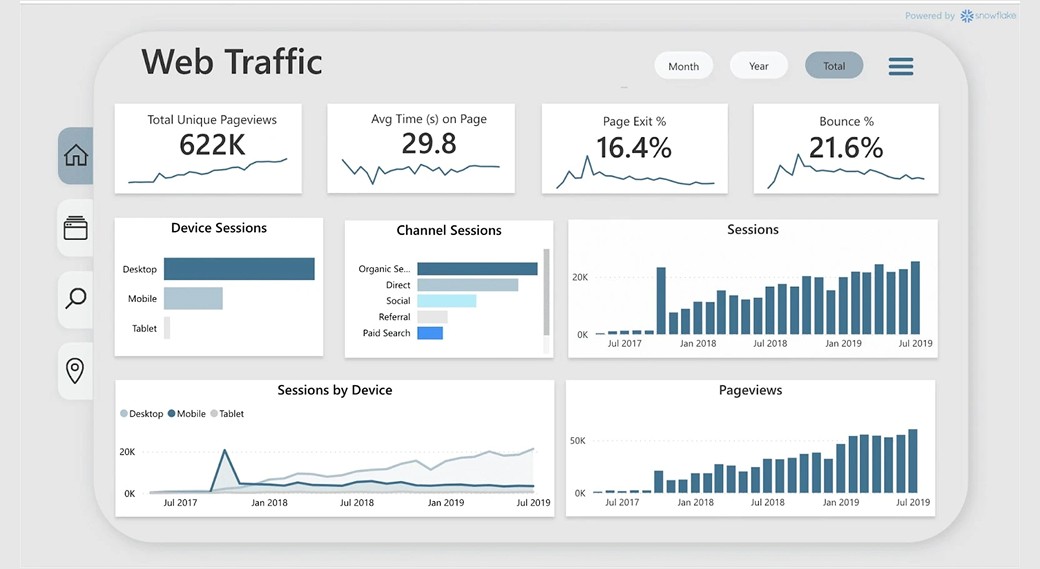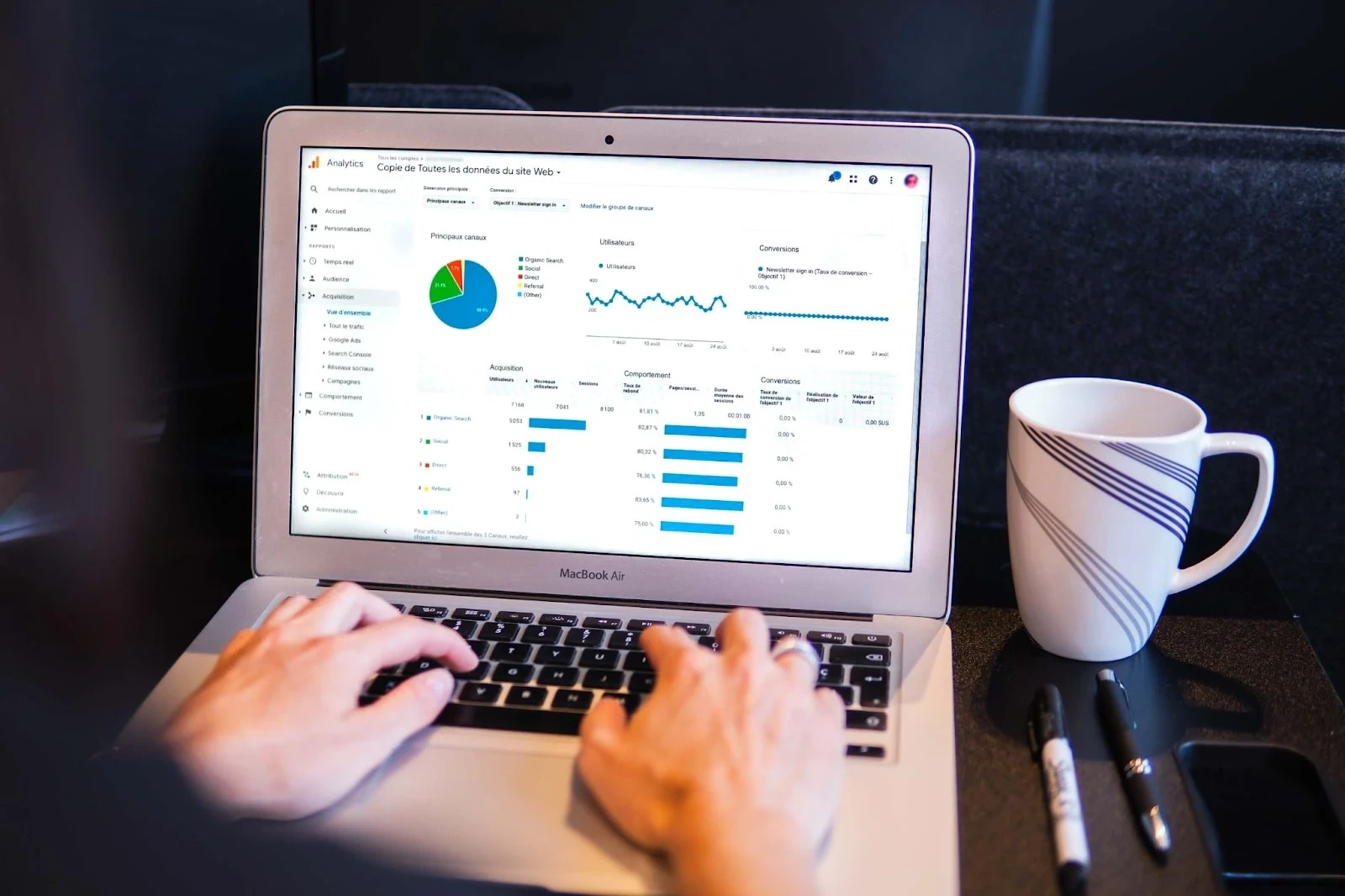
Oğuz Kağan Yalçın
5 Min Read
Discover the benefits of customized BI dashboards and how they can provide tailored insights to support your unique business goals.
Introduction
A business intelligence dashboard, known as a BI dashboard, is a tool that visually presents key performance indicators (KPIs) and vital business metrics on a single screen for an organization, department, team, or process. Typically part of most BI software platforms, these dashboards offer analytics to executives and employees. They might also be called business dashboards, business intelligence tools, or data dashboards. Usually, they include various visual data representations, offering a comprehensive view of relevant KPIs and trends for both operational decision-making and strategic planning. Compared to static BI reports, BI dashboards are more interactive, often allowing users to access the underlying data for deeper analysis through charts and graphs. Depending on the situation, these dashboards can be designed by BI teams or created by business analysts and users of self-service BI tools. In today’s article, we are going to take a deeper look into the customized BI dashboards and its benefits.
Contents
BI Dashboards
Business Intelligence Solutions
The Benefits of Customized BI Dashboard
BI Dashboards
We mentioned a little above, but let's take a more in-depth look. Dashboards serve as comprehensive business intelligence solutions, consolidating vital metrics and key performance indicators onto a single screen for users to effortlessly monitor and assess business performance. They offer quick insights such as trends and anomalies, catering to users of various skill levels before delving deeper into data analysis using advanced tools like contextual analytics. Acting as a high-level reporting mechanism, dashboards swiftly address critical business inquiries, aiding decision-making by communicating performance against set targets, enhancing informational awareness, organizing operational data systematically, and presenting intricate relationships in a digestible format. Drawing data from files, APIs, and services, these dashboards compile reports—combinations of metrics and dimensional data views—providing users a comprehensive grasp of their key metrics and influential factors. They showcase information through tables, cross-tabular reports, or diverse visualizations like charts, graphs, and maps, sometimes accommodating user-defined filters, images, and text across multiple tabs for a holistic understanding.
Business Intelligence Solutions
BI dashboard software incorporates crucial elements beyond interactivity. These include a personalized interface, pre-designed dashboard templates for faster creation, and the capability to access both historical and live data. These tools provide collections of widgets, icons, and images to streamline functions, enhance usability, and augment visual attractiveness within dashboards. Additionally, they incorporate practical navigation features like tabs, drop-down menus, and other functionalities to improve user experience.
BI dashboards are composed of key elements:
Data Connections: These dashboards link to various data sources like data warehouses, data marts, or operational systems, ensuring access to a wide array of analytics data. They also integrate external data feeds for real-time updates.
Visual Representations: Configurable with diverse visualizations, from basic charts like line and bar graphs to more intricate displays such as scatter plots or heat maps, dashboards exhibit multiple performance metrics and statistics.
Tabular Data: Incorporating data tables presenting key values, dashboards use color coding or visual cues to emphasize critical information, like highlighting sales declines or financial losses, for swift comprehension.
Drill-Down Functionality: Users engage with more detailed data by clicking on visualizations, navigating to hierarchical layers of additional visualizations or data tables, facilitating in-depth analysis.
Data Filters: Interactive filters allow customization, permitting users to focus on specific parameters like date ranges or geographic settings, refining the displayed information.
Textual Elements: Dashboards incorporate text boxes and tooltips that elucidate the visualized data or provide supplementary context and insights about the analytics results.
The Benefits of Customized BI Dashboard
BI dashboards simplify intricate data for non-technical users within organizations. While IT might generate initial content, business users gain autonomy to craft and access their personalized dashboards. This self-service BI capability empowers non-technical individuals to engage directly with data. Through dashboard-driven data visualizations, business users can detect trends, spot positive shifts, isolate negative patterns, and even obtain predictive insights. For instance, when Charles Schwab allowed numerous bank branches to devise individual dashboards, they efficiently tracked product-related customer satisfaction without sifting through extensive spreadsheets.
In other words, a cloud-based dashboard offers accessibility from any location, provided the user has the right credentials. This feature enables team members to access dashboards at their convenience, allowing managers and leaders to constantly monitor their KPIs. Immediate access means they can address issues in real-time rather than waiting until the start of the workweek. Moreover, dashboards and visualizations spark an interest in data exploration. Employees can swiftly delve deeper into data to uncover answers to issues not immediately apparent.
Also, enabling automatic updates reduces the BI team's dashboard creation and maintenance time. This time efficiency allows them to redirect efforts towards other tasks or dedicate more attention to data analysis. Now, checking the current status of a KPI merely involves a quick glance at the dashboard, eliminating the need to manually generate reports elsewhere. Additionally, if users frequently compare data from different sources, creating a dashboard simplifies this process, eliminating the need to toggle between multiple tools.
BI dashboards present real-time data from diverse sources in easily understandable visual formats. Managers leverage this snapshot of current KPIs to assess different performance aspects and derive actionable insights. Well-designed dashboards prioritize clarity and brevity, concentrating on essential performance indicators for swift comprehension. This approach allows users to track and adapt their performance on an hourly or even minute-to-minute basis.
In summary, customized BI dashboards are indispensable tools for businesses seeking to harness the full power of their data. They offer clarity, immediacy, and depth in data analysis, empowering decision-makers at every level. Understanding the immense value and transformative potential of these dashboards, VIZIO.AI stands ready to be your partner in this journey. Our expertise in creating bespoke BI dashboards is unparalleled, and we are committed to tailoring solutions that align perfectly with your unique business needs and goals. From seamless integration with your existing systems to providing real-time, insightful analytics, VIZIO.AI’s solutions are designed to enhance your decision-making process and propel your business forward. Don’t let your data's potential remain untapped. Reach out to VIZIO.AI today and unlock the full potential of your business with our state-of-the-art BI dashboard solutions.
If you like this article, you can check out our other articles.





